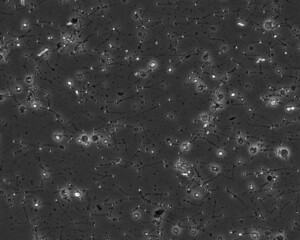Relevance of round cells detection in spermograms
A spermogram consists of analyzing the sperm of a man or an animal to evaluate the fertility and find out any possible anomalies. Round cells are known to be one of the most likely anomalies, encompassing lymphocytes, plasma cells, macrophages, mast cells, and round tumor cells. Consequently, the detection of these kinds of cells is very relevant to assess the health of an individual. However, the sperm samples may contain at least 15 million spermatozoa per ml of semen, with the sample volume ranging between 1.5 and 5 ml in humans[1]. This high number of sperms turns the task of finding round cells tedious through the microscope, which could take a lot of time. To show the complexity of the analysis, Figure 1 shows as an example an image containing, apart from spermatozoon, multiple types of elements, like round cells.

Figure 1 – Example of an image taken from an electronic microscope of a sperm sample.
The rise of Artificial Intelligence applications has enabled the decrease of the time of analysis in many tasks. Hence, analyzing images or texts that take a human being a huge amount of time can be conducted in seconds by an intelligent system. Within Artificial Intelligence, there are various fields, including Computer Vision, which involves processing images to gain insights into patterns, segment parts of images, and detect objects, shapes, or textures.
In Computer Vision, intelligent models like YOLO (You Only Look Once) have revolutionized object detection by achieving high performance in identifying people, vehicles, animals, and even medical anomalies such as cancer cells. The popular real-time object detection algorithm can predict bounding boxes and class probabilities simultaneously in a single pass of a Convolutional Neural Network (CNN). It divides an image into grids and predicts bounding boxes and object classes within each grid, optimizing detection speed and accuracy.
Leveraging YOLO capabilities, the GVIS research group from the University of León (gvis.unileon.es) has been working closely with Hamilton Thorne Spain (before, Microptic), in solving the problem of round cells detection in semen sample images. Hamilton Thorne Spain (Microptic) supplied the GVIS group with a dataset containing images of sperm samples obtained with a light microscope, apart from the experience of locating round cells inside them. Then, GVIS researchers labeled the whole dataset so it could be used to train versions 7 and 8 of YOLO to detect round cells. Figure 2 illustrates the outcomes of applying the YOLO-based model, which accurately identifies and localizes these round cells. The model delineates their appearance with bounding boxes and assigns a probability score ranging from 0 to 1.

Figure 2 – Results from YOLO, where the model has labeled round cells using bounding boxes and assigned a probability score
Eduardo Fidalgo Fernández
Associate Professor
Industrial, Computer Sciences and Aeronautics Engineering School
[1] https://medlineplus.gov/spanish/ency/article/003627.htm Accessed July 2024



Leave A Comment